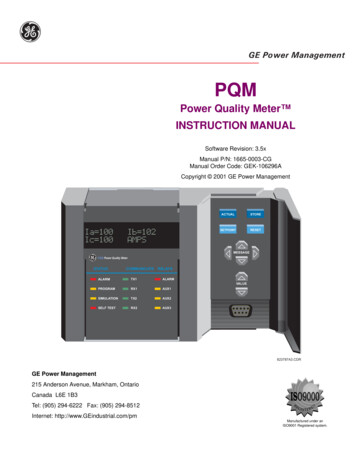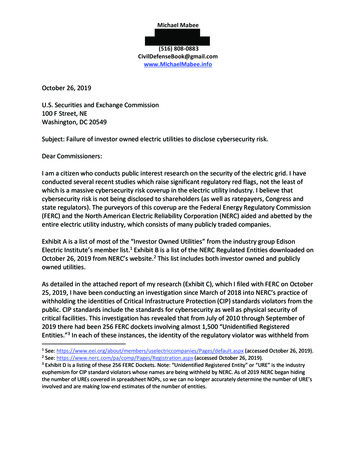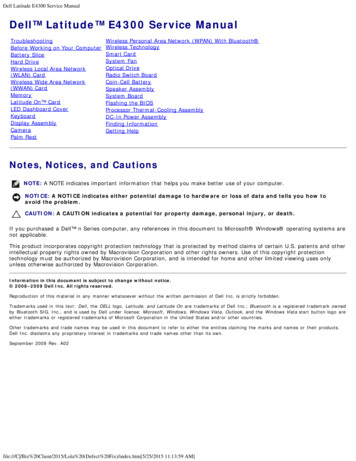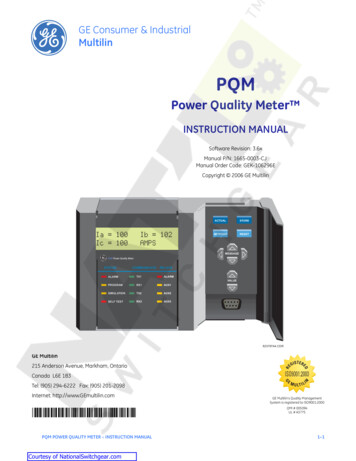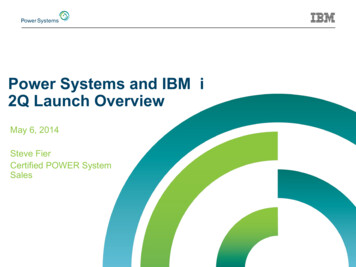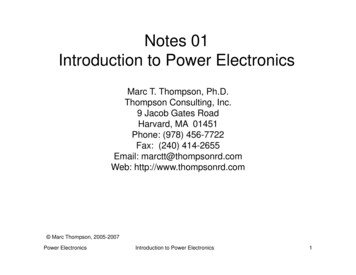
Transcription
Notes 01Introduction to Power ElectronicsMarc T. Thompson, Ph.D.Thompson Consulting, Inc.9 Jacob Gates RoadHarvard, MA 01451Phone: (978) 456-7722Fax: (240) 414-2655Email: marctt@thompsonrd.commarctt@thompsonrd comWeb: http://www.thompsonrd.com Marc Thompson, 2005-2007Power ElectronicsIntroduction to Power Electronics1
Introduction to Power Electronics Power electronics relates to the control and flow ofelectrical energy Control is done using electronic switches, capacitors,magnetics, and control systems ScopeSoff power electronics:l t imilliWattsilliW tt gigaWattsi W tt Power electronics is a growing field due to theimprovement in switching technologies and the need formore and more efficient switching circuitsPower ElectronicsIntroduction to Power Electronics2
Summary History/scope of power electronicsSome interesting PE-relatedPE related projectsCircuit concepts important to power electronicsSome tools for approximate analysis of powerelectronicsl t i systemst DC/DC converters --- first-cut analysis Key design challenges in DC/DC converter design Basic system conceptsPower ElectronicsIntroduction to Power Electronics3
Scope of Power ElectronicsPower Level (Watts) System0.1-10 Battery-operated equipment Flashes/strobes10-100 Satellite power systems Typical offline flyback supply100 – 1kW Computer power supply Blender1 – 10 kW Hot tub10 – 100 kW Electric car Eddy current braking100 kW –1 MW Bus micro-SMES1 MW – 10 MW SMES10 MW – 100 MW Magnetic aircraft launch Big locomotives100 MW – 1 GW Power plant 1 GW SandyS d PPondd substationb t ti (2.2(2 2 GW)Power ElectronicsIntroduction to Power Electronics4
Scope of Power ElectronicsPower ElectronicsIntroduction to Power Electronics5
Areas of Application of Power Electronics High frequency powerconversion– DC/DC, inverters Low frequency powerconversion– Line rectifiers Distributed ppowersystems Power devicesPower Electronics Power Transmission– HVDC– HVAC Power quality– Power factorcorrection– Harmonic reduction PassivePi filtfilteringi Active filteringIntroduction to Power Electronics6
Some Applications Heating and lighting controlInduction heatingFluorescent lamp ballasts– Passive– Active – Electronic ignitions– AlternatorsMotor drivesBattery chargersElectric vehicles Switching power suppliesSpacecraft power systems– Battery powered– Flywheel poweredPower ElectronicsEnergy storage– Flywheelsy– Capacitors– SMES– Motors– Regenerative braking Uninterruptible powersupplies (UPS)Electric power transmissionAutomotive electronics Power conditioning foralternative power sources– Solar cells– Fuel cells– Wind turbinesIntroduction to Power Electronics7
Some Power Electronics-Related ProjectsWorked on at TCI (Harvard Labs) High speed lens actuatorLaser diode pulsersLevitated flywheelMaglevPermanent magnet brakesSwitching power suppliesMagnetic analysisLaser driver pulsers50 kW inverter switchTranscutaneous (through-skin) non-contact power supplyPower ElectronicsIntroduction to Power Electronics8
Lens ActuatorzrIronCoilBack ironLensPermanentNd-Fe-BogMagnetAir gapPower ElectronicsIntroduction to Power Electronics9
High Power Laser Diode Driver Based ongyPower Converter TechnologyOverdriveduration setOVERDRIVESwitchingArrayArrayDriverLaser DiodeIodTHRESH. currentsetO.D. KSwitchingArray-12IsPEAK currentsetRsenseDiff. ee:1.B. Santarelli and M. Thompson, U.S. Patent #5,123,023, "Laser Driver with Plural Feedback Loops," issued June 16, 19922.M. Thompson, U.S. Patent #5,444,728, "Laser Driver Circuit," issued August 22, 19953.W. T. Plummer, M. Thompson, D. S. Goodman and P. P. Clark, U.S. Patent #6,061,372, “Two-Level Semiconductor LaserDriver,” issued May 9, 20004.Marc T. Thompson and Martin F. Schlecht, “Laser Diode Driver Based on Power Converter Technology,” IEEETransactions on Power Electronics, vol. 12, no. 1, Jan. 1997, pp. 46-52Power ElectronicsIntroduction to Power Electronics10
Magnetically-LevitatedMagneticallyLevitated Flywheel Energy Storage For NASA; P 100W, energy storage 100 W-hrsGuidance and SuspensionSNNSFlywheel (Rotating)NSSNSNNSStator WindingNSSNNSSNzNSSNrPower ElectronicsIntroduction to Power Electronics11
Electromagnetic Suspension --- MaglevPower ElectronicsIntroduction to Power Electronics12
Maglev - German TransrapidPower ElectronicsIntroduction to Power Electronics13
Maglev - Japanese EDSPower ElectronicsIntroduction to Power Electronics14
Japanese EDS GuidewayPower ElectronicsIntroduction to Power Electronics15
MIT Maglev Suspension MagnetReference: M. T. Thompson, R. D. Thornton and A. Kondoleon, “Flux-canceling electrodynamic maglevsuspension: Part I.I Test fixture design and modelingmodeling,” IEEE Transactions on Magnetics,Magnetics vol.vol 3535, nono. 33, May 1999pp. 1956-1963Power ElectronicsIntroduction to Power Electronics16
MIT Maglev Test FixtureM. T. Thompson, R. D. Thornton and A. Kondoleon,“FluxFlux-cancelingcanceling electrodynamic maglev suspension:Part I. Test fixture design and modeling,” IEEETransactions on Magnetics, vol. 35, no. 3, May 1999 pp.1956-1963Power ElectronicsIntroduction to Power Electronics17
MIT Maglev Test Fixture 2 meter diametertest wheel Max. speed 1000RPM (84 m/s) ForF testingt ti “flux“flcanceling” HTSCMaglev Sidewall levitation“electrodynamic maglev suspension: Part I. Test fixturefM. T. Thompson, R. D. Thornton and A. Kondoleon, “Flux-cancelingdesign and modeling,” IEEE Transactions on Magnetics, vol. 35, no. 3, May 1999 pp. 1956-1963Power ElectronicsIntroduction to Power Electronics18
Permanent Magnet Brakes For roller coasters10,000000 Braking force 10Newtons per meter of brakeReference: http://www.magnetarcorp.comPower ElectronicsIntroduction to Power Electronics19
Halbach Permanent Magnet Array Special PM arrangement allows strong side (bottom)and weak side (top) fields Applicable to magnetic suspensions (Maglev), linearmotors, and induction brakesPower ElectronicsIntroduction to Power Electronics20
Halbach Permanent Magnet ArrayPower ElectronicsIntroduction to Power Electronics21
Linear Motor Design and AnalysisPower ElectronicsIntroduction to Power Electronics22
Variac Failure AnalysisPower ElectronicsIntroduction to Power Electronics23
PhotovoltaicsReference: S. Druyea, S. Islam and W. Lawrance, “A battery management system for stand-alone photovoltaic energysystems,” IEEE Industry Applications Magazine, vol. 7, no. 3, May-June 2001, pp. 67-72Power ElectronicsIntroduction to Power Electronics24
Offline Flyback Power SupplyReference: PP. MaigeMaige, “AA universal power supply integrated circuit for TV and monitor applicationsapplications,” IEEE Transactionson Consumer Electronics, vol. 36, no. 1, Feb. 1990, pp. 10-17Power ElectronicsIntroduction to Power Electronics25
Transcutaneous Energygy TransmissionReference: HH. MatsukiMatsuki, YY. YamakataYamakata, NN. ChubachiChubachi, SS.-I.-I Nitta and H.H Hashimoto,Hashimoto “TranscutaneousTranscutaneous DC-DCconverter for totally implantable artificial heart using synchronous rectifier,” IEEE Transactions on Magnetics,vol. 32 , no. 5, Sept. 1996, pp. 5118 - 5120Power ElectronicsIntroduction to Power Electronics26
50 KW Inverter SwitchPower ElectronicsIntroduction to Power Electronics27
Non Contact Battery ChargerNon-ContactPower ElectronicsIntroduction to Power Electronics28
High Voltage RF SupplyPower ElectronicsIntroduction to Power Electronics29
60 Hz Transformer Shielding StudyPower ElectronicsIntroduction to Power Electronics30
“Intuitive Analog Circuit Design”Power ElectronicsIntroduction to Power Electronics31
“Power Quality in Electrical Systems”Power ElectronicsIntroduction to Power Electronics32
Some Other Interesting Power-ElectronicsRelated SystemsPower ElectronicsIntroduction to Power Electronics33
Conventional vs.vs Electric CarPower ElectronicsIntroduction to Power Electronics34
High Voltage DC (HVDC) TransmissionPower ElectronicsIntroduction to Power Electronics35
Mass SpectrometerReference: http://www.cameca.fr/doc en pdf/oral sims14 schuhmacher ims1270improvements.pdfPower ElectronicsIntroduction to Power Electronics36
Some Disciplines Encompassed in theField of Power Electronics Analog circuits– High speed (MOSFETswitching, etc.)– High power– PC bboardd llayoutt– Filters EMI Machines/motorsSimulation– SPICE, Matlab, etc. Device physics– How to make a betterMOSFET, IGBT, etc. Control theoryMagnetics– Inductor design– Transformer design Thermal/cooling– How to design a heat sink– Thermal interfaces– Thermal modelingPower systems– Transmission lines– Line filteringPower ElectronicsIntroduction to Power Electronics37
Selected History of Power Switching Devices 1831 --- Transformer actiondemonstrated by Michael Faraday 1880s: modern transformer inventedReference:fJ. W. Coltman,C““The Transformerf(historical(overview,”” IEEEIndustry Applications Magazine, vol. 8, no. 1, Jan.-Feb. 2002, pp. 8-15Power ElectronicsIntroduction to Power Electronics38
Selected Historyy of Power Switchingg Devices Early 1900s: vacuum tube– Lee DeForest --- triode, 1906 1920-1940:1920 1940 mercury arc ttubesb ttoconvert 50Hz, 2000V to3000VDC for railwayReference: M. C. Duffy, “The mercury-arc rectifier and supplyto electric railways,” IEEE Engineering Science andEducation Journal, vol. 4, no. 4, August 1995, pp. 183-192Power ElectronicsIntroduction to Power Electronics39
Selected History of Power Switching Devices 1930s: selenium rectifiers 1948 - Silicon Transistor(BJT) introduced (Bell Labs) 1950s - semiconductor powerdiodes begin replacingvacuum tubes 1956 - GE introduces SiliconControlled Rectifier (SCR)fN. Holonyak, Jr., “The“SiliconSp-n-p-n SwitchSand ControlledCRectifierf (Thyristor),”() ” IEEE Transactions onReference:Power Electronics, vol. 16, no. 1, January 2001, pp. 8-16Power ElectronicsIntroduction to Power Electronics40
Selected History of Power Switching Devices 1960s - switching speed of BJTs allow DC/DC converterspossible in 10-20 kHz range 1960 - Metal Oxide Semiconductor Field-EffectField Effect Transistor(MOSFET) for integrated circuits 1976 - power MOSFET becomes commercially available,allows 100 kHz operationReference: B. J. Baliga, “Trends in Power Semiconductor Devices,” IEEE Transactions on Electron Devices, vol. 43,no. 10, October 1996, pp. 1717-1731Power ElectronicsIntroduction to Power Electronics41
Selected History of Power Switching Devices 1982 - Insulated Gate Bipolar Transistor (IGBT) introducedReference: B. J. Baliga, “Trends in Power Semiconductor Devices,” IEEE Transactions on Electron Devices, vol. 43,no. 10, October 1996, pp. 1717-1731Power ElectronicsIntroduction to Power Electronics42
Review of Basic Circuit Concepts Some background in circuits Laplace notation First-order and secondorder systems Resonant circuits,dampingp g ratio,, Q Reference for this material: M.T. Thompson, Intuitive AnalogCircuit DesignDesign, Elsevier,Elsevier 2006(course book for ECE529) andPower Quality in ElectricalSystems, McGraw-Hill, 2007 byA. Kusko and M. ThompsonPower ElectronicsIntroduction to Power Electronics43
LaplacepNotation Basic idea: Laplace transform converts differentialequation to algebraic equation Generally,Gll methodth d iis usedd iin sinusoidaliid l steadyt d statet tafter all startup transients have died outCircuit domainResistance, RInductance LCCapacitanceiCR1vi -R1 R2CPower ElectronicsLaplace (s) domainRLs1Csvo-vi (s) -Introduction to Power ElectronicsR21/(Cs) vo(s)-44
System Function Find “transfer function” H(s) by solving Laplace transformedcircuitR1vi -R2CH ( s) Power ElectronicsR1 vovi (s)-R2 -R21/(Cs) vo(s)-1CsR2Cs 1vo ( s ) ( R1 R2 )Cs 1vi ( s ) R R 112CsIntroduction to Power Electronics45
First-Order Systems tvo (t ) V (1 e τ ) tV τir (t ) eRτ RCTime constantτ R 2.2τωh Risetime1τωhfh 2πPower ElectronicsBandwidth0.35τR fhIntroduction to Power Electronics46
First-Order Stepp and Frequencyqy ResponsepStep Response1Amplitudde0.80.60.40.200123456Time (sec.)Phhase (deg); Magnitudee (dB)Bode Diagrams0-10-20-20-40-60-80-110Power Electronics010Frequency (rad/sec)Introduction to Power Electronics11047
Review of Second-OrderSecond Order SystemsRL vi -Cvo-1Csω n2vo ( s )11 2 2H ( s) 22ζsLCs RCs 1 ss 2ζω n s ω n2vi ( s ) R Ls 1 12Csωn ωn1LCω RC 1 R1 Rς n 22 L 2 ZoCNatural frequencyqy ωn Damping ratioPower ElectronicsIntroduction to Power Electronics48
Second-Order System Frequency ResponseH ( jω ) H ( jω ) 12 jςω ω 2 1 2 ωn ωn 12 2ςω ω 2 1 2 ωn ωn 2 2ςω 1 ω n 1 2ςωω n H ( jω ) tan tan 22 2ωn ω ω 1 2 ωn Power ElectronicsIntroduction to Power Electronics49
Second-OrderSecondOrder System Frequency Response Plots show varying damping ratioFrequency response for natural frequency 1 and various damping ratios302010Phase (deg); Maagnitude (dB)0-10-20-30-400-50-100-150-110010110Frequency (rad/sec)Power ElectronicsIntroduction to Power Electronics50
Second-Order System Frequency Responseat Natural Frequency Now, what happens if we excite this system exactly at thenaturalt l frequency,for ω ωn? ThThe response iis:H ( s ) ω ωn1 2ς H ( s )ω ωn Power ElectronicsπIntroduction to Power Electronics251
Relationship Between Damping Ratio and“Quality Factor” Q A second order system can also be characterized by its“Q lit F“QualityFactor”t ” or “Q”H ( s ) ω ωPower Electronicsn1 Q2ςIntroduction to Power Electronics52
Second-Order System Step Response Shown for varying values of damping ratioStep ResponseStep response for natural frequency 1 and various damping 678910Time (sec.)Power ElectronicsIntroduction to Power Electronics53
Second-Order Mechanical System Electromechanical modelingReference: Leo Beranek, Acoustics, Acoustical Society of America, 1954Power ElectronicsIntroduction to Power Electronics54
Pole Location Variation with DampingVery underdampedCriticallydampedOverdampedjωjωjωx jω nσ ωnxσxσx2 polesx jω nPower ElectronicsIntroduction to Power Electronics55
Undamped Resonant CircuitiL vcCL-Now, we can find the resonant frequency by guessing that the voltage v(t) issinusoidal with v(t) Vosinωt. Putting this into the equation for capacitor voltageresults in:1 ω sin(ωt ) sin(ωt )LC2This means that the resonant frequency is the standard (as expected) resonance:ω r2 Power Electronics1LCIntroduction to Power Electronics56
Energy MethodsiL vcCL-By using energy methods we can find the ratio of maximumcapacitor voltage to maximum inductor current. Assuming that thecapacitorit isi iinitiallyiti ll chargedhd tto Vo volts,lt andd rememberingb i ththatt2capacitor stored energy Ec ½CV and inductor stored energy isEL ½LI2, we can write the following:11 22CVo LI o22Power ElectronicsIntroduction to Power Electronics57
Energy MethodsiL vcCLWhat does this mean about the magnitude of the inductor current ? Well,we can solve for the ratio of Vo/Io resulting in:VoL ZoCIoThe term “ZZo” is defined as the characteristic impedance of a resonantcircuit. Let’s assume that we have an inductor-capacitor circuit with C 1microFarad and L 1 microHenry. This means that the resonant frequencyis 106 radians/second (or 166.7 kHz) and that the characteristic impedancei 1 OhisOhm.Power ElectronicsIntroduction to Power Electronics58
SimulationiL vcCL-Power ElectronicsIntroduction to Power Electronics59
Typical Resonant Circuit Model of a MOSFET gate drive circuit1Cs11vo ( s )H ( s) 2212ζsvi ( s ) R Ls LCs RCs 1 s 12Csωn ωn1LCω RC 1 R1 Rς n 22 L 2 ZoCωn Power ElectronicsIntroduction to Power Electronics60
Resonant Circuit --- Underdamped With ““small”ll” resistor,i t circuiti it iis underdampedd ddωn 1 200 Mrad / secLCf n 31.8 MHzL 5ΩZo Cω n RC 1 R1 Rς 0.00122 L 2 ZoCPower ElectronicsIntroduction to Power Electronics61
Resonanteso a CCircuitcu --- UUnderdampedde da ped Resultsesu s This circuit is very underdamped, so we expect steppto oscillate at around 31.8 MHzresponse Expect peaky frequency response with peak near 31.8 MHzωn 1 200 Mrad / secLCf n 31.8 MHzL 5ΩCω n RC 1 R1 R 0.001ς 22 L 2 ZoCZo Power ElectronicsIntroduction to Power Electronics62
Resonanteso a CCircuitcu --- UUnderdampedde da ped Results,esu s,Step Response Rings at around 31.8 MHzPower ElectronicsIntroduction to Power Electronics63
Resonanteso a CCircuitcu --- UUnderdampedde da ped Results,esu s,Frequency Response Frequency response peaks at 31.8 MHzPower ElectronicsIntroduction to Power Electronics64
Resonanteso a CCircuitcu --- CCriticalca Dampinga p g Now, let’s employ “critical damping” by increasing valueof resistor to 10 Ohms This is also a typical MOSFET gate drive dampingresistor valuePower ElectronicsIntroduction to Power Electronics65
CriticalCca Damping,a p g, SStepep Responseespo se Note that response is still relatively fast ( 100 nsptime)) but with no overshootresponse If we make R larger, the risetime slows downPower ElectronicsIntroduction to Power Electronics66
CriticalCca Damping,a p g, Frequencyeque cy Responseespo se No overshoot in the transient response corresponds topeakingg in the frequencyqy responsepno pPower ElectronicsIntroduction to Power Electronics67
Circuit Concepts Power– Reactive power– Power quality– Power factor RootR t MeanMSSquare(RMS) Harmonics– Harmonic distortionPower ElectronicsIntroduction to Power Electronics68
Sinewaves A sinewave can beexpressed as v(t) Vpksin(ωt) Vpk peak voltage ω radian frequency(rad/sec) ω 22πff where f is in Hz VRMS Vpk/sqrt(2) 120V for sinewave withpeaks at 170V More on RMS laterPower Electronics120V RMS 60 Hz oduction to Power .0140.016690.018
Sinewave with Resistive Load v(t) and i(t) are in phase and have the same shape;i.e. no harmonics in current- Time representation-PhasorPhrepresentationt ti-In this case, V and Ihave the same phasepPower ElectronicsIntroduction to Power Electronics70
Sinewave with Inductive Load For an inductor, remember that v Ldi/dt So, i(t) lags v(t) by 90o in an inductorPower ElectronicsIntroduction to Power Electronics71
Sinewave with Inductive Load --- PSIMPower ElectronicsIntroduction to Power Electronics72
Sinewave with L/R Load Phase shift (also called angle) between v and i is somewherebetween 0o and -90o ωL tan R 1Power ElectronicsIntroduction to Power Electronics73
Sinewave with Capacitive Load Remember that i Cdv/dt for a capacitor Current leads voltage by 90o- Phasor representationPower ElectronicsIntroduction to Power Electronics74
Phasor Representation of L and CIn inductor, current lagsg byy 90 degreesgvoltagePower ElectronicsIn capacitor, voltage lagscurrent by 90 degreesIntroduction to Power Electronics75
Response of L and C to pulsesPower ElectronicsIntroduction to Power Electronics76
Review of Complex Numbers In “rectangular” form, a complex number is written in terms ofreal and imaginary components A Re(A) j Im(A)- Angle Im( A) θ tan Re( A) 1- Magnitude of AA Power ElectronicsIntroduction to Power Electronics(Re(( A) )2 (Im(( A) )277
Find Polar Form Assume that current I -3.53 5 j(4j(4.2)2)I ( 3.5) 2 ( 4.2) 2 5.5 Aθ 180o γ 4.2 oγ tan 50.2 3.5 θ 180o 50.2 o 129.8o 1 5.5 A 129.8oPower ElectronicsIntroduction to Power Electronics78
Converting from Polar to Rectangular FormRe{A} A cos(θ )Im{A} A sin(θ )Power ElectronicsIntroduction to Power Electronics79
Power “Power” has many shapes and forms– Real powerp– Reactive power Reactive power does not do real work– Instantaneous powerp (t ) v(t )i (t )– PeakP k instantaneousi t tpower– Average power1p (t ) TPower ElectronicsT v(t )i (t )dt0Introduction to Power Electronics80
Power Factor Ratio of delivered power to the product of RMS voltage andRMS current P PF VRMS I RMS Power factor always 1With pure sine wave and resistive load, PF 1With ppure sine wave and ppurelyy reactive load,, PF 0Whenever PF 1 the circuit carries currents or voltagesthat do not perform useful work The more “spikey”spikey a waveform is the worse is its PF– Diode rectifiers have poor power factor Power factor can be helped by “power factor correction”Power ElectronicsIntroduction to Power Electronics81
Causes of Low Power FactorFactor--- L/R Load Power angle is θ tan-1(ωL/R) For L 1H1H, R 377 OhmsOhms, θ 45o and PF cos(45o) 0.707Power ElectronicsIntroduction to Power Electronics82
Causes of Low Power Factor --- Non-linear Load Nonlinear loads include: Variable-speed drives Frequency converters Uninterruptable powersupplies (UPS) Saturated magneticcircuits Dimmer switches Televisions Fluorescent lamps Welding sets Arc furnaces Semiconductors BatteryB ttchargershPower ElectronicsIntroduction to Power Electronics83
Half Wave Rectifier with RC Load In applications where cost is a major consideration, acapacitive filter may be used. If RC 1/f then this operates like a peak detector and theoutput voltage vout is approximately the peak of the inputvoltage Diode is only ON for a short time near the sinewave peaksPower ElectronicsIntroduction to Power Electronics84
Half Wave Rectifier with RC Load Note poor power factor due to peaky input line currentPower ElectronicsIntroduction to Power Electronics85
Unity Power Factor --- Resistive Load Example: purely resistive load– Voltage and currents in phasev(t ) V sin ωtVi (t ) sin ωtRV2sin 2 ωtp(t ) v(t )i (t ) RV2 p(t ) 2RVVRMS 2VI RMS R 2V2 p(t ) 2RPF 1VRMS I RMS V V 2 R 2 Power ElectronicsIntroduction to Power Electronics86
Causes of Low Power Factor --- Reactive Load Example: purely inductive load– Voltage and currents 90o out of phasev(t ) V sin ωtVi (t ) cos ωtωLV2p(t ) v(t )i (t ) sin ωt cos ωtωL p (t ) 0 For purely reactiveload PF 0load,PF 0Power ElectronicsIntroduction to Power Electronics87
Why is Power Factor Important? Consider peak-detector full-wave rectifier Typical power factor kp 0.6 What is maximum power you can deliver to load ?– VAC x current x kp x rectifier efficiency– (120)(15)(0.6)(0.98) 1058 Watts Assume you replace this simple rectifier by powerelectronics module with 99% power factor and 93%yefficiency:– (120)(15)(0.99)(0.93) 1657 WattsPower ElectronicsIntroduction to Power Electronics88
Power Factor Correction Typical toaster can draw 1400W from a 120VAC/15A line Typical offline switching converter can draw 1000Wbecause it has poor power factor High power factor results in:– Reduced electric utility bills– Increased system capacity– Improved voltage– Reduced heat losses Methods of power factor correction– Passive Add capacitors across an inductive load to resonate Add inductance in a capacitor circuit– ActivePower ElectronicsIntroduction to Power Electronics89
Power Factor Correction --- Passive Switch capacitors in and out as needed as load changesPower ElectronicsIntroduction to Power Electronics90
Power Factor Correction --- Active Fluorescent lamp ballast applicationPower ElectronicsIntroduction to Power Electronics91
Root Mean Square (RMS) Used for description of periodic, often multi-harmonic,waveforms Square root of the average over a cycle (mean) of thesquare of a waveformTI RMS 1 2i (t )dt T 0 RMS current of any waveshape will dissipate the sameamount of heat in a resistor as a DC current of the samevalue– DC waveform: Vrms VDC– Symmetrical square wave: IRMS Ipk– Pure sine wave0 0 pk IRMS 0.707I Example: 120 VRMS line voltage has peaks of 169.7 VPower ElectronicsIntroduction to Power Electronics92
Intuitive Description of RMS The RMS value ofa sinusoidal orother periodicwaveformdissipates thesame amount ofpower in a resistiveload as does abatteryy of the sameRMS value So, 120VRMS intoa resistive loaddissipates as muchpower in the loadas does a 120VbatteryPower ElectronicsIntroduction to Power Electronics93
RMS Value of Various Waveforms Following are a bunch of waveforms typically found in powerelectronics, power systems, and motors, and theircorresponding RMS values Reference: R. W. Erickson and D. Maksimovic,Fundamentals of Power Electronics, 2nd edition, Kluwer, 2001Power ElectronicsIntroduction to Power Electronics94
DC Voltage BatteryPower ElectronicsIntroduction to Power Electronics95
Sinewave AC linePower ElectronicsIntroduction to Power Electronics96
Square Wave This type of waveform can be put out by a square waveconverter or full-bridge converterPower ElectronicsIntroduction to Power Electronics97
DC with Ripple Buck converter inductor current (DC value ripple)Power ElectronicsIntroduction to Power Electronics98
Triangular Ripple Capacitor ripple current in some converters (no DC value)Power ElectronicsIntroduction to Power Electronics99
Pulsating Waveform Buck converter input switch current (assuming small ripple)Power ElectronicsIntroduction to Power Electronics100
Pulsating with Ripple i.e. buckconverter switchcurrent We can usethis result to getRMS value ofbuck diodecurrentPower ElectronicsIntroduction to Power Electronics101
TriangularPower ElectronicsIntroduction to Power Electronics102
Piecewise Calculation This works if the different components are at differentfrequenciesPower ElectronicsIntroduction to Power Electronics103
Piecewise Calculation --- Example WhatWh t isi RMS valuel off DC ripplei l ((shownhbbefore)?f )?Power ElectronicsIntroduction to Power Electronics104
Harmonics Harmonics are created by nonlinear circuits– Rectifiers Half-wave rectifier has first harmonic at 60 Hz Full-wave has first harmonic at 120 Hz– Switching DC/DC converters DC/DC operating at 100 kHz generally createsharmonics at DC, 100 kHz, 200 kHz, 300 kHz, etc. LineLi harmonicshi can beb ttreatedt d byb liline filtfilters– Passive– ActivePower ElectronicsIntroduction to Power Electronics105
Total Harmonic Distortion Total harmonic distortion (THD)– Ratio of the RMS value of all the nonfundamentalfrequency terms to the RMS value of the2fundamentalI22 THD n 1n , RMSI1, RMS I RMS I1, RMSI12, RMS Symmetrical square wave: THD 48.3%I RMS 1I1 42π2 4 1 2π 0.483THD 2 4 2π Symmetrical triangle wave: THD 12.1%Power ElectronicsIntroduction to Power Electronics106
Half-Wave Rectifier, Resistive Load Simplest, cheapest rectifier Line current has DC component; this current appears inneutral High harmonic content, Power factor 0.7P.F . Power ElectronicsIntroduction to Power ElectronicsPavgVRMS I RMS107
Half Wave Rectifier with Resistive Load --- PowerF t andFactord AverageAOutputO t t VoltageV ltAverage output voltage:1 v d 2π π0V pk sin(i (ωt )d (ωt ) V pk2π[ cos((ωt )]ωt πωt 0 V pkπPower factor calculation:22I pk1 I pk R P R2 2 4VRMS V pkI RMS I pk 12 22 RI pk22I pkR P 4 0.707 PF IIVRMS I RMS pk pk 1 R 2 2 2 Power ElectronicsIntroduction to Power Electronics108
Half-Wave Rectifier, Resistive Load --- Spectrumoff LLoaddVVoltageltPower ElectronicsIntroduction to Power Electronics109
Half Wave Rectifier with RC Load More practical rectifier For large RC, this behaves like a peak detectorPower ElectronicsIntroduction to Power Electronics110
Half Wave Rectifier with RC Load Note poor power factor due to peaky line current Note DC component of line currentPower ElectronicsIntroduction to Power Electronics111
Half Wave Rectifier with RC Load --SSpectrumtoff LineLi CurrentCtPower ElectronicsIntroduction to Power Electronics112
Crest Factor Another term sometimes used in power engineering Ratio of peak value to RMS value ForF a sinewave,icrestt factorf t 1.414– Peak 1; RMS 0.707 For a square wave, crest factor 1– Peak 1; RMS 1Power ElectronicsIntroduction to Power Electronics113
Harmonics and THD - Sinewave THD 0%Number of harmonics N 1 THD 0 %151.510.50-0.5-1-11.55Power Electronics00.010.020.030.040.05Introduction to Power Electronics0.060.07114
Harmonics and THD - Sinewave 3rd HarmonicPower ElectronicsIntroduction to Power Electronics115
Harmonics and THD --- Sinewave 3rd 5thHarmonic THD 38.9%Power ElectronicsIntroduction to Power Electronics116
Harmonics --- Up to N 103 THD 48%Power ElectronicsIntroduction to Power Electronics117
Full Wave Rectifier (Single Phase)Full-WavePower ElectronicsIntroduction to Power Electronics118
Full-Wave Rectifier with Capacitor FilterPower ElectronicsIntroduction to Power Electronics119
6-Pulse (3-Phase) Rectifier Typically used for higher-power applications where 3phase power is availablePower ElectronicsIntroduction to Power Electronics120
12-Pulse Rectifier TTwo paralleledll l d 66-pulsel rectifierstifi 5th and 7th harmonics are eliminated Onlyy harmonics are the 11th, 13th, 23rd, 25th Reference: R. W. Erickson and D. Maksimovic, Fundamentals of Power Electronics, 2d editionPower ElectronicsIntroduction to Power Electronics121
Techniques for Analysis of Power ElectronicsCircuits Power electronics systems are often switching,nonlinear,liandd withith otherth ttransients.i t A varietyi t offtechniques have been developed to helpapproximatelyppy analyzey these circuits– Assumed states– Small ripple ass
Power Electronics Introduction to Power Electronics 40 Reference: N. Holonyak, Jr., “The Silicon p-n-p-n Switch and Controlled Rectifier (Thyristor),” IEEE Transactions on Power Ele

